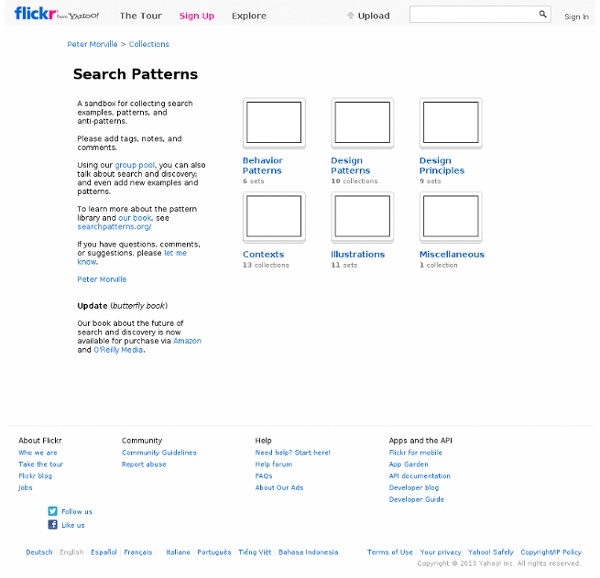



Patterns in Interaction Design So You Wanna Build a Library, Eh? The following article is an abridged version of Chapter 7 of Nathan Curtis’s 2009 book, Modular Web Design published by New Riders. The book’s first half addresses how to modularly break down your design, build it back up, and communicate in new and interesting ways. With those design techniques in hand, the book then drills into how to organize and build a library, teach it to others, and establish a process for maintaining it for an organization. Design patterns and modular components are effective techniques for designing and building long-lasting, consistent experiences. You may reach the point where you ask yourself “Is it time to build a library for our team?” Many teams have realized incredible efficiencies, savings, and better design through design libraries and related standards. Therefore, precede any kind of library build out with a period of discernment. 1. What is your primary rationale for building a library? Portability: Designers come and go. 2. 3. 4. 5. 6. 7. 8.
Patternry | User Interface Design Patterns for Ideas and Inspiration UI Design Pattern Library Guide to Website Navigation Design Patterns In web design, there are certain common design patterns that are used for interaction. Site navigation has a wide variety of common and familiar design patterns that can be used as a foundation for building effective information architecture for a website. This guide covers popular site navigation design patterns. For each site navigation design pattern, we will discuss its common characteristics, its drawbacks, and when best to use it. Top Horizontal Bar Navigation Top horizontal bar navigation is one of the two most popular kinds of site navigation menu design patterns out there. The top horizontal bar navigation design pattern is sometimes paired with drop-down menus whereby hovering on a navigation item reveals second-level child navigation items. Common Characteristics of Top Horizontal Bar Navigation Navigation items are text links, button-shaped, or tabbed-shapedHorizontal navigation is often placed directly adjacent to the site’s logoIt is often located above the fold Tabs Navigation
509 Bandwidth Limit Exceeded Index - 4ourth Mobile Design Pattern Library Designing Mobile Interfaces: Patterns for Interaction Design is a comprehensive reference for mobile design patterns. Whether designing for smartphones, featurephones or other related devices, common principles are discussed and codified as 76 universal interaction and interface patterns. Aside from suggestions, each pattern lists pitfalls and implementations to avoid. Every pattern is grouped with similar or optional patterns, and explained with the underlying psychology and physiology. Along with appendices detailing mobile technologies, type and design principles and human factors, you will have a base of knowledge to make up your own mind, and react to the always-changing mobile environment. "Designing Mobile Interfaces is another stellar addition to O’Reilly’s essential interface books. Buy it from Amazon: Buy it direct from O'Reilly: Or, you can just read it right here on this wiki. Read in other languages Preface Designing Smartphone Interfaces The Patterns Additional Topics References
Main Page - Social Patterns Responsive Web Design Patterns | This Is Responsive Responsive Patterns A collection of patterns and modules for responsive designs. Submit a pattern Layout Reflowing Layouts Equal Width Off Canvas Source-Order Shift Lists Grid Block Navigation Single-Level Multi-level Breadcrumbs Pagination Images Responsive Image Techniques Media/Data Video Fluid Video Iframes Tables Charts & Graphs Responsive Chart Forms Basic Forms Text Lettering Fittext Footnotes Responsive Footnotes Modules Carousel Tabs Accordion Messaging Lightbox
What Makes Them Click » Blog Archive » 100 Things You Should Know About People: #49 — The Brain Looks For Simple Patterns - Applying Psychology to Understand How People Think, Work, and Relate What do you see when you look at the x’s below? xx xx xx xx Chances are you will say you see four sets of 2 x’s each. You won’t see them as 8 separate x’s. You interpret the white space, or lack of it, as a pattern. People are great at recognizing patterns – Recognizing patterns helps you make quick sense of all the sensory input that comes to you every second. Individual cells respond to certain shapes – In 1959, two researchers, Hubel and Wiesel showed that there are individual cells in the visual cortex of your brain that respond only to horizontal lines, other cells that respond only to vertical lines, other cells that respond to edges, and cells that respond only to certain angles. You recognize objects by simple shapes – But research now points to the idea that we recognize certain basic shapes in what we are looking at, and we use these basic shapes, called geons, to recognize objects. Take-Aways: What do you think? And for those of you who like to read the research:
CSS3 Patterns Gallery Browser support The patterns themselves should work on Firefox 3.6+, Chrome, Safari 5.1, Opera 11.10+ and IE10+. However, implementation limitations might cause some of them to not be displayed correctly even on those browsers (for example at the time of writing, Gecko is quite buggy with radial gradients). Also, this gallery won’t work in Firefox 3.6 and IE10, even though they support gradients, due to a JavaScript limitation. Submission guidelines If you have a new pattern to submit, please send a pull request. Does it present a new technique? 43 Essential Controls for Web Applications Designing a web application? Familiarize yourself with Rich Internet Application technologies and the best UI controls for creating your application. Rich Internet Application technology has empowered us to create really amazing user experiences. Most of these libraries, toolkits, and/or frameworks have an online gallery of controls (also called components, widgets, UI controls) you should explore. Many products are siloed by the RIA framework they are using, and designers create novel controls when the framework doesn’t have what they need.